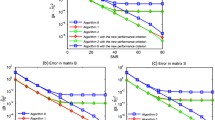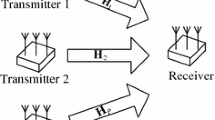Abstract
An independent component analysis (ICA) based CDMA receiver is proposed, which in addition to the independence of users also exploits the independence of pseudo-codes in user signal separation. The proposed scheme is termed as independent code division multiple access in contrast to orthogonal code division multiple access being used in conventional CDMA receivers. Independence of pseudo-codes has been invoked by introducing the so-called independent Gram-Schmidt process in a deflation based ICA algorithm. The independence via Gram-Schmidt process is claimed by taking the inner product of successive vectors in a nonlinearly transformed Hilbert space, incorporating higher order statistics, instead of that in the original Euclidean space. The proposed receiver has been shown to outperform the existing CDMA receivers, in terms of bit error rate, through simulations. Moreover, the introduction of nonlinear transformation is shown to have no adverse effect on the convergence of the original deflation based ICA algorithm in terms of number of iterations apart from the computational cost of nonlinear transformation at each step. Gold codes are used for the demonstration of the proposed scheme although more work is needed to be done in order to identify the code family more amenable to the independence property.









Similar content being viewed by others
References
Albataineh, Z., & Salem, F. M. (2017). Adaptive blind CDMA receivers based on ICA filtered structures. Circuits, Systems, and Signal Processing, 36(8), 3320–3348.
Dahlman, E., Parkvall, S., & Skld, J. (2011). 4G LTE/LTE-advanced for mobile broadband. Oxford: Academic.
Cristescu, R., Ristaniemi, T., Joutsensalo, J., & Karhunen, J. (2000). Blind separation of convolved mixtures for CDMA systems. In European signal processing conference, Tampere (pp. 1–4).
Ekici, O., & Yongacoglu, A. (2004). Application of noisy-independent component analysis for CDMA signal separation. In VTC2004-fall (Vol. 5, pp. 3812–3816).
El-Khamy, S. E., & Abed, M. (2006). Performance enhancement of downlink multiuser DS-CDMA detectors using processing by independent component analysis. In International conference on computer engineering and systems, Cairo (pp. 237–243).
Ristaniemi, T., & Joutsensalo, J. (2000). Advanced ICA-based receivers for DS-CDMA systems. In 11th IEEE international symposium on personal indoor and mobile radio communications. PIMRC 2000. Proceedings (Cat. No.00TH8525), London (Vol. 1, pp. 276–281).
Ristaniemi, T., & Joutsensalo, J. (1999). Independent component analysis with code information utilization in DS-CDMA signal separation. In Proc. IEEE global telecommunications conference (GLOBECOM’99), Rio de Janeiro, December 5–9 (Vol. 1a, pp. 320–324).
Ristaniemi, T., & Joutsensalo, J. (2002). Advanced ICA-based receivers for block fading DS-CDMA channels. Signal Processing, 82(3), 417–431.
Ristaniemi, T., & Joutsensalo, J. (1998). Novel scheme for blind symbol separation in CDMA downlink. In Proc. 32nd Asilomar conference on signals, systems, and computers, Monterey (pp. 1853–1857).
Hyvarinen, A., Karhunen, J., & Oja, E. (2001). Independent component analysis. New York: Wiley.
Jen, C.-W., & Jou, S.-J. (2014). Blind ICA detection based on second-order cone programming for MC-CDMA system. EURASIP Journal on Advances in Signal Processing, 151, 1–14.
Luo, Z., & Zhu, L. D. (2015). A charrelation matrix-based blind adaptive detector for DS-CDMA systems. Sensors, 15, 20152–20168.
Lou, Z., & Li, C. (2016). Second-order code programming based robust blind multiuser detector for CDMA systems. International Journal of Future Generation Communication and Networking, 9(9), 153–168.
Glisic, S., & Vucetic, B. (1997). Spread spectrum CDMA systems for wireless communications (1st ed.). Boston: Artech House.
Bensely, S., & Aazhang, B. (1998). Subspace-based channel estimation for code division multiple access communication systems. IEEE Transactions on Communications, 44(8), 1009–1020.
Hyvarinen, A., & Oja, E. (2000). Independent component analysis: algorithms and applications. Neural Networks, 13(4–5), 411–430.
Hyvarinen, A. (1997). A fast fixed-point algorithm for ICA. Neural Computation, 9, 1483–1492.
Hyvarinen, A. (1999). Gaussian moments for noisy independent component analysis. IEEE Signal Processing Letters, 6, 145–147.
Ristaniemi, T., & Joutsensalo, J. (1999). On the performance of blind source separation in CDMA downlink. In Proceedings of the international workshop on independent component analysis and signal separation, Aussois (pp. 437–441).
Yun-rui, G., Di, H., Chen, H., & Ling-Ge, J. (2008). A HOS-based blind signal extraction method for chaotic MIMO systems. Journal of Shanghai Jiaotong University (Science), 13(1), 21–25.
Feller, W. (1968). Probability theory and its applications (3rd ed.). New York: Wiley.
Jutten, C., & Herault, J. (1991). Blind separation of sources, part I: An adaptive algorithm based on neuromimetic architecture. Signal Processing, 24, 1–10.
Hyvarinen, A. (1999). Fast and robust fixed-point algorithms for independent component analysis. IEEE Transactions on Neural Networks, 10, 626–634.
Miettinen, J., Nordhausen, K., Oja, H., & Taskinen, S. (2014). Deflation-based fast ICA with adaptive choices of nonlinearities. IEEE Transactions on Signal Processing, 62(21), 5716–5724.
Raju, G., & Charoensakwiroj, J. (2003). Orthogonal codes performance in multi-code CDMA. In IEEE int. conf. on systems, man and cybernetics (Vol. 2, pp. 1928–1931).
Turkmani, A. M. D., & Goni, U. S. (1993). Performance evaluation of maximal length, gold and Kasami codes as spreading sequences in CDMA systems. ICUPC, 2, 970–974.
Proakis, J. (2001). Digital communications (4th ed.). New York: McGraw-Hill.
Taneja, H. C. (2009). Statistical methods for engineering and sciences. New Delhi: I K International Publishing House.
Acknowledgements
We would like to thank Higher Education Commission Pakistan for providing funds under HEC indigenous scholarship program [112-26769-2EG1-033(50021028)].
Author information
Authors and Affiliations
Corresponding author
Additional information
Publisher's Note
Springer Nature remains neutral with regard to jurisdictional claims in published maps and institutional affiliations.
Rights and permissions
About this article
Cite this article
Anjum, I., Syed, A.A. & Rizvi, A.A. Independent Code Division Multiple Access in DS-CDMA. Wireless Pers Commun 117, 1717–1733 (2021). https://doi.org/10.1007/s11277-020-07443-7
Published:
Issue Date:
DOI: https://doi.org/10.1007/s11277-020-07443-7




